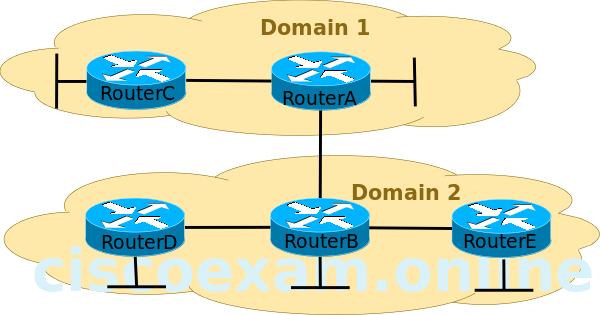
RouterA and RouterB are Anycast RPs that are configured as MSDP multicast peers. The following partial output is from the show running-config command on RouterA:
interface Loopback0
ip address 192.168.1.1 255.255.255.255
!
interface Loopback1
ip address 192.168.1.2 255.255.255.255
!
ip msdp peer 192.168.1.3 connect-source loopback1 remote-as 2
ip msdp originator-id loopback1
ip pim rp-address 192.168.1.1
The following partial output is from the show running-config command on RouterB:
interface Loopback0
ip address 192.168.1.1 255.255.255.255
!
interface Loopback1
ip address 192.168.1.3 255.255.255.255
!
ip msdp peer 192.168.1.2 connect-source loopback1 remote-as 1
ip msdp originator-id loopback1
ip pim rp-address 192.168.1.1
RouterC is configured to use Auto-RP to discover the Anycast RP. RouterD is configured to use BSR to discover the Anycast RP. RouterE is configured with the ip pim rp-address 192.168.1.3 command.
Which of the following statements is correct?
| A. |
RouterA and RouterB cannot use the same IP address on Loopback 0 | |
| B. |
RouterA and RouterB cannot be in different domains | |
| C. |
RouterC cannot use AutoRP to discover the Anycast RP | |
| D. |
RouterD cannot use BSR to discover the Anycast RP | |
| E. |
RouterE is not configured with the correct IP address of the Anycast RP |
RouterE is not configured with the correct IP address of the Anycast rendezvous point (RP). Anycast RP enables multiple RPs to provide redundancy and loadsharing capabilities. Each downstream router uses the closest RP. If an Anycast RP fails or is added, the Protocol Independent Multicast (PIM) network will converge as quickly as IP routing converges. You should configure each of the Anycast RPs as Multicast Source Discovery Protocol (MSDP) peers of one another by issuing the ip msdp peer command for each Anycast RP peer.
RouterA and RouterB must use the same IP address on a loopback interface; this address is the Anycast RP address. In this scenario, RouterA and RouterB are correctly using the 192.168.1.1 address on Loopback 0. When an Anycast RP fails, the downstream routers will not have to discover a new RP; they will continue to use the shared IP address of the Anycast RPs.
Each downstream router must be configured with the shared IP address of the AnycastRPs, either statically by using the ip pim rpaddress command or dynamically by using AutoRP or Bootstrap Router (BSR). In this scenario, RouterE is configured with the ip pim rpaddress 192.168.1.3 command. However, the Loopback 0 interfaces of RouterA and RouterB are configured with the shared IP address 192.168.1.1. Therefore, RouterE should be configured with the ip pim rpaddress 192.168.1.1 command. RouterC is correctly configured to use AutoRP to discover the RP address, and RouterD is correctly configured to use BSR to discover the RP address.
RouterA and RouterB can be in different domains. In fact, MSDP enables Anycast RPs to share information about multicast sources across domains. Without MSDP, an Anycast RP would be able to know about multicast sources only within its own domain.